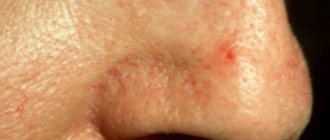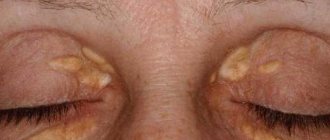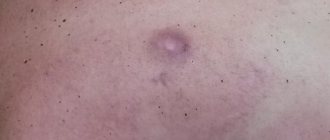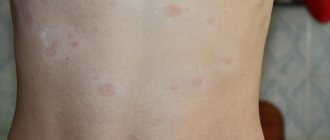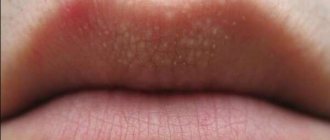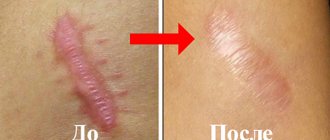- Is this a common occurrence?
- Cleft lip and other pathologies
- Problems for babies with cleft lip
- Defect formation time
- Causes of vice
- Classification
- Treatment of cleft lip
- What does preparation for surgery include?
- Cleft lip removal surgery
- Rehabilitation period
- Cleft lip after surgery
- Contraindications
- Reviews
- Video
Cleft lip , or in medical language cheiloschisis , is a malformation of the maxillofacial region of a newborn in the form of a cleft (cleft) of his upper lip.
Cleft lip
This congenital defect is formed due to the fact that during the prenatal period the tissues of the nasal cavity and upper jaw do not fuse together in the fetus.
The defect is not a threat to the child’s life, but it significantly and for the worse changes his appearance and ability to develop the necessary skills associated with the speech apparatus. That is why it is best to remove a cleft lip as soon as possible.
Problems for babies with cleft lip
- Cosmetic defect (external deformity)
- Difficulty speaking
- Inability to smile
- Difficulty eating (sucking and swallowing in infants)
- Problems of speech development
- The need for special dental care products
The defect is formed in the womb.
With deep clefts, the newborn can be fed through a nasal tube. Subsequently, due to deformation of the teeth and bite, the processes of chewing food are disrupted.
Incorrect development of the dentition leads to the missing of some teeth or, conversely, to the formation of additional ones, their growth at the wrong angle, and a tendency to caries. This, in turn, will require the intervention of an orthodontist to correct the bite, which is sometimes accompanied by transplantation of excess teeth or implantation of missing ones.
Due to a disruption in the sound formation process, children with a cleft lip experience a disorder of speech function (rhinolalia). As a result, the speech of children with such a defect is unclear, it has a pronounced new sound (the so-called “nasality”), and it is difficult for them to pronounce consonants.
The defect can be detected on ultrasound
Consequences and complications
Cleft lip and cleft palate are birth defects that can be corrected. Most children born with these deformities can undergo plastic surgery to restore function and appearance, making it possible for these children to live healthy and happy lives.
Although the prognosis for children who receive treatment and support is good, there are physical, medical, and social problems associated with cleft lip and palate, and family members of children with this pathology should be aware of them.
Speech : Children born with a cleft lip or palate are more likely to have speech problems - delayed speech development. More than half of children with deformities require treatment from a speech therapist. Each type of treatment depends on the individual case.
Feeding : Babies with cleft lip and palate have difficulty feeding due to the gap in the lip or palate. Food and drink can pass from the mouth into the nasal cavity through this communication. There are special bottles and nipples to ensure that food enters the esophagus and then into the stomach. It is best to feed children with a cleft palate in an upright position. The use of an obturator (prosthetic palate) allows children to eat well before surgery.
Ear Infection/Hearing Loss : If a child has a cleft palate, the Eustachian tubes (canals that connect the ear and throat) and external auditory canals may not be positioned correctly. As a result, these children are susceptible to middle ear infection (otitis media) due to increased fluid levels. Recurrent ear infections can lead to hearing loss. This is why children with cleft palates need special tubes placed in their eardrums to drain fluid. This minor surgery may be performed during cleft reconstruction.
Dental problems: As a result of deformation of the arch of the mouth, teeth may erupt incorrectly or not at all. In such cases, it is necessary to use artificial teeth and orthodontic devices (braces). Maintain good oral hygiene by brushing and flossing your teeth to prevent gum disease (periodontitis) and prevent tooth decay. If the size and shape of a regular toothbrush is not suitable for your child, use a toothette (also called travel toothbrushes) - these are disposable toothbrushes that are a soft sponge soaked in mouthwash.
Psychological aspects : Most children and adults with cleft lip or palate do not experience major social or psychological problems. All thanks to surgery, which corrects deformities and visible defects at an early age. However, some people with cleft lip or palate do not like their appearance and therefore feel upset and unhappy. Psychological support from a psychologist, family members, teachers and doctors helps to cope with this.
Causes of vice
Cleft lip is formed at the gene level due to a mutation in the TBX22 gene. But this mutation can be provoked by:
- toxicosis;
- stress;
- antibiotic abuse;
- exposure to radiation;
- viral infections (toxoplasmosis, herpes, cytomegalovirus, rubella);
- taking drugs, drinking alcohol and smoking by the expectant mother;
- late birth (when the woman giving birth is over 40 years old);
- chronic diseases in the mother.
Do not smoke!
These factors pose the main danger during the first two months of pregnancy.
Approximate scale of the influence of unfavorable factors on the development of cleft lip:
- 23% – chemical;
- 9% – mental;
- 6% – mechanical injuries;
- 5% – biological;
- 2% – physical, etc.
Causes
Soft and hard tissues of the maxillofacial area are formed by the end of the 8th week of pregnancy. The correct formation of these structures is influenced by both hereditary and external factors.
Also, the development of the defect can be influenced by “breakage” of chromosomes. Regardless of the type of defect - cleft palate or cleft lip, the causes of their occurrence are the same.
The share of hereditary factors in the occurrence of cheiloschisis or cleft palate accounts for about 25%.
This issue has not yet been fully studied. Genetics come to the conclusion that the cause of the development of these pathologies is the action of several genes at once. This is also indicated by the fact that the risk of developing cleft palate and cleft lip in subsequent generations is only 7%.
Chromosome abnormalities account for only 15%. In this case, the newborn also has other multiple severe malformations, combined into entire syndromes.
The remaining 40% comes from external pathogenic factors that affected the fetus in the first 2 months of pregnancy. Some factors come directly from the mother's lifestyle and can be easily adjusted:
- smoking during pregnancy, which increases the risk of developing anomalies by 2 times;
- narcotic substances cause cleft lip or cleft palate in children 10 times more often;
- excessive consumption of alcohol and its substitutes;
- the use of certain groups of antiepileptic drugs and antibiotics;
- lack of vitamin B9 (folic acid), which every pregnant girl needs to take, starting from the first weeks of gestation.
There is a group of internal risk factors that, unfortunately, a pregnant woman cannot influence (non-modifiable)
- the age of the pregnant woman is over 35-40 years;
- fetal hypoxia in early pregnancy;
- partial detachment of the chorion, which causes insufficient nutrition of the tiny fetus and inhibits its development.
And finally, external environmental factors:
chronic intoxication with pesticides, benzene, mercury or lead.
This can happen if the expectant mother lives near industrial plants or works in a hazardous industry.
Classification
Congenital cleft lip occurs:
1) one-sided:
- complete, in which there is a complete splitting of the upper lip from the nostril to the red border of the lips;
- incomplete, when part of the lip tissue in the upper part is preserved;
- hidden, characterized by splitting of the lip muscles while maintaining the skin and mucous membrane;
2) double-sided:
- symmetrical, when the cleft on both sides is complete or incomplete;
- asymmetrical, when on one side the cleft is complete, and on the other - incomplete or hidden.
The most common is unilateral cleft of the upper lip to the left of its midline, rarely - bilateral, as well as the lower lip.
In the case of a bilateral cleft, the premaxillary process of the maxilla protrudes forward.
Technique for eliminating cleft palate
With the help of radical uranoplasty, it is possible to restore the child’s normal nutrition and improve the quality of his speech. Among such operations, the most common is plastic surgery using the Limberg method. If there is also a cleft lip, the upper lip is corrected (cheiloplasty).
The operation to correct the defect involves general anesthesia, which includes the following steps:
- induction anesthesia;
- tracheal intubation;
- anesthesia support;
- withdrawal from anesthesia.
The best time for such intervention is between 3 and 6 years of age. Up to 5 years of age, operations are performed on patients with non-through cleft palates, from 5 to 6 years – on patients with through (unilateral and bilateral) ones. If uranoplasty is performed earlier, there is a risk of delayed development of the upper jaw.
Before surgery, children are recommended to wear a “floating” obturator (a prosthesis to close the defect) to allow normal nutrition, breathing and speech development. This prosthesis is removed two weeks before surgery.
Treatment of cleft lip
The treatment of the defect is plastic surgery. There are three types of operations depending on their complexity and invasiveness:
- reconstructive cheiloplasty. It is used in the presence of only a cleft lip in order to restore its natural structure;
- rhinocheiloplasty. This operation affects a large number of organs, for example, cartilage and muscles;
- Rhinocheilognatoplasty. This is an even more complex surgical procedure that affects the formation of the muscular frame of the child’s jaw.
The operation itself is complex and rarely leads to a 100% result the first time. Usually this involves several procedures. However, with successful plastic surgery, complications are a rare occurrence.
Know that today the diagnosis of “cleft lip” is not a death sentence, but only a qualified specialist can treat this defect!
Treatment of cleft lip or palate
Children with a cleft lip or cleft palate undergo treatment for 18 months to several years. Treatment involves a team of professionals and begins from birth through adulthood. This group includes specialists from different fields of health care who collaborate to take into account all individual, sometimes very difficult, characteristics.
[google]
Particular attention in treatment is paid to restoring normal function, speech, appearance and improving the quality of life. The cleft lip or palate repair team usually includes:
Oral and Maxillofacial Surgeon : Performs surgery to realign the upper jaw to restore function, appearance, and cleft palate and lip repair.
Plastic surgeon : also performs necessary surgeries for cleft palate and lip plastic surgery, as well as procedures to restore facial and soft tissue deformities.
Dentist/Pediatric Dentist/Prosthodontist : These dentists provide oral hygiene, preventative and therapeutic treatments, and make restorations and appliances to restore functions such as chewing and speech.
Orthodontist : An orthodontist straightens or moves teeth.
ENT doctor (otolaryngologist) : monitors hearing and recommends treatment.
Audiologist: Evaluates hearing impairments that may affect a person's communication.
Speech therapist: develops speech and phonetic abilities of patients.
Nurse: Monitors the patient's health.
Psychologist/Social Worker: provides support to the child and his family in the process of correcting deformities.
Geneticist: explains to parents and adult patients the likelihood of having a child with a cleft.
Cleft lip removal surgery
The average age of a child at surgery is from 3 to 6 months. Depending on the severity of the defect, an appropriate type of reconstruction of the upper lip is performed, and, if necessary, restoration of the nasal cartilage. In addition, due to the effect on the muscular system of the mouth, its functionality increases.
After the surgeon has completed the reduction and sutured the split tissue of the lip and nose, he places a gauze pad in the baby's nasal passage to protect the fresh stitches from food and mucus and to prevent narrowing of the child's nasal passage.
If the operation is not performed in the first six months of the baby’s life, then when the child is older (for example, at 3 years old), after the operation he will already need serious treatment from a speech therapist and procedures to eliminate scars.
Factors that cause cleft palate and cleft lip
The specific factors responsible for the occurrence of cleft lip and cleft palate are unknown, but these deformities are thought to be the result of an interaction of genetic and environmental factors. If you or someone in your family has had a cleft palate or cleft lip, your baby is more likely to be born with a deformity.
Environmental factors that may be a possible cause include exposure to antiepileptic drugs, acne medications, alcohol and tobacco, illegal drugs (such as cocaine, heroin, crack), vitamin A derivatives, and other chemicals/toxins.
Reviews
Maria: I'm 30 years old. I had 3 surgeries, the first at 4 months, the next at 4 years and the last at 13 years. Now there is a slight crooked nose and a scar on the lip, but it is not noticeable. At the moment I don’t feel any complexes about it. Advice to parents: there is no need to hide the truth from your child. My parents lied to me, saying that I just had a bad fall as a child. As a result, I didn’t learn the truth from them, at the age of 12, and not in the best way. It was very unpleasant.
Alesya: Now my daughter is 11 years old. There is still cosmetic surgery ahead and some minor nose trimming once the skull and nose have fully grown. There is a scar, but not critical. Nothing negative so far. Perhaps she will be worried during her difficult adolescence, but I will try to smooth out this problem.
Tamara: When I was pregnant with my youngest daughter, no one told me anything. Even after giving birth, none of the doctors noticed anything! My daughter had a very small cleft palate, only near the uvula. It was just when she yawned that I noticed something was wrong. I went to the doctor and he confirmed that the palate had not partially fused. We had surgery when we were one year old, and now everything is fine. There is no more defect. Three months after the operation, my daughter began to speak and is developing well. I almost forgot that there was some kind of problem.
Features of the pathology of the cleft palate
This is what is called a cleft palate. This is a congenital malformation characterized by a cleft of the hard and soft palate. The formation of the defect occurs as a result of incomplete fusion of the processes of the upper jaw with the vomer, an unpaired bone located in the facial area of the skull.
There are two types of cleft palate in a child, which are determined by the complexity of the pathology. Cleft palate may be complete or incomplete. In the first case, there is a cleft in the hard and soft palate, in the second - only a hole. Cleft lip and cleft palate are often combined. These two pathologies very often develop simultaneously.
Reasons for the development of pathology
The formation of a cleft of the hard and soft upper palate is facilitated by a number of factors that, during pregnancy, cause certain disturbances in the development of the fetus. Pathology of the upper jaw can be the result of one or more of the reasons listed below.
- Bad habits. If during pregnancy a woman smokes, drinks alcohol and drugs, especially in the first trimester, this can negatively affect the development of the fetus. Because of this, a cleft of the hard palate, signs of a cleft lip, and other equally serious anomalies may appear.
- Forced use of drugs with a teratogenic effect, which provoke various malformations in the first trimester of pregnancy.
- Living in an unfavorable environmental environment.
- Work in production involving hazardous chemicals.
- Serious deficiency of folic acid in a woman’s body.
- Pathology of the upper jaw can be transmitted from parents. Inheritance comes from mother, father and other close relatives. If a family has already given birth to a child with this pathology, then a cleft palate may develop during the next pregnancy.
- When the mother is over 35 years old, children with various developmental anomalies are also much more likely to be born.
Research conducted in this area shows that the main cause of cleft palate in children is gene mutation. At the same time, physical and mental development as a whole is not impaired.
No later than the fourth month of pregnancy, ultrasound results can already reveal pathology. But this is only if the defect is severe. With minor splitting, it is found only in a newborn baby.
How dangerous is the pathology?
Both complete and hidden clefts of the soft palate interfere with many natural physiological processes, significantly reducing the child’s quality of life. Only a recently born baby immediately faces the consequences of this defect.
- During childbirth, aspiration of amniotic fluid in newborns often occurs.
- Difficulty breathing.
- The baby is underweight due to the inability to suck. Therefore, until the time of the operation, special devices in the form of spoons are used to feed babies, which are placed on the nipples.
- Hearing and speech functions are impaired.
- The digestive and respiratory systems also suffer.
- Cleft lip and palate allow fluid and food to enter the nose.
- Subsequently, bite deformation is observed.
Given the wide range of consequences for the body, surgical intervention is required to restore chewing, respiratory and speech functions.
Treatment methods
Cleft lip and cleft palate are pathologies that can only be eliminated surgically. During the operation, the integrity of the alveolar process is restored and palate plastic surgery is performed. The birth of a baby with such a pathology should prepare parents for the fact that they will have to turn to a variety of specialists, since a pediatrician, orthodontist, maxillofacial surgeon, otolaryngologist, and speech therapist take part in the treatment. In combination, it is possible not only to eliminate the external manifestations of the defect, but also to completely restore all the most important functions .
The operation cannot be performed immediately after the baby is born. It is prescribed no earlier than 3-6 months. In order to completely eliminate the defect, more than one operation is required. Usually their number varies from 3 to 7. In some cases, this disease may require more operations. They are completed by the age of 6-7 years. Since the defect looks very unaesthetic, until this time additional cosmetic procedures are carried out to improve the child’s appearance.
